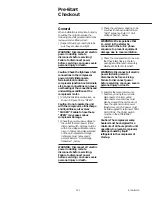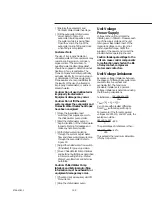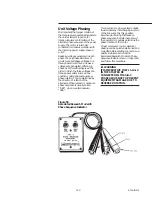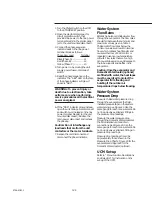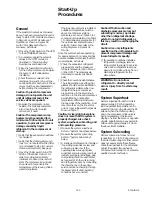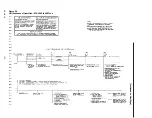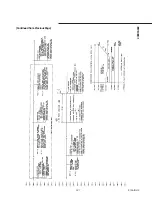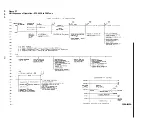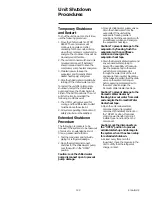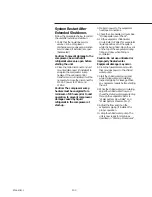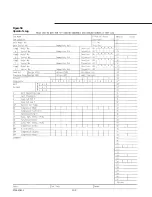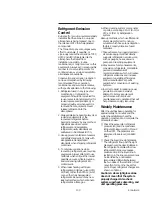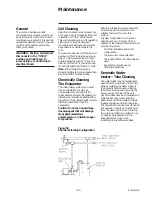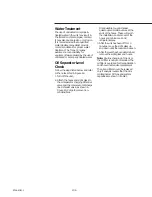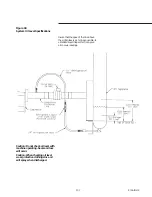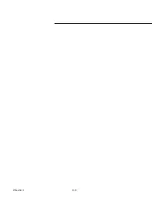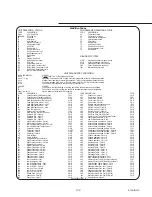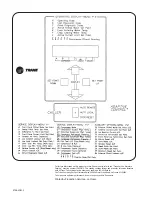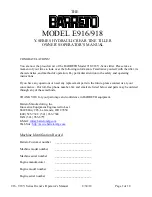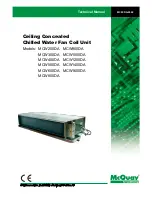
134
RTAA-IOM-3
[ ] If operating pressures and sight
glass conditions seem to indicate
refrigerant shortage, measure the
system superheat and system
subcooling. Refer to “System
Superheat” and “System
Subcooling”.
[ ] If operating conditions indicate a
refrigerant overcharge, remove
refrigerant at the liquid line service
valve. Allow refrigerant to escape
slowly, to minimize oil loss. Do not
discharge refrigerant into the
atmosphere.
WARNING: Do not allow
refrigerant to directly contact
skin or injury from frostbite may
result.
[ ] Inspect the entire system for
unusual conditions and inspect the
condenser coils for dirt and debris. If
the coils are dirty, refer to “Coil
Cleaning”.
Monthly Maintenance
[ ] Perform all weekly maintenance
procedures.
[ ] Measure and record the system
superheat. Refer to “System
Superheat”.
[ ] Measure and record the system
subcooling. Refer to “System
Subcooling”.
[ ] Manually rotate condenser fans to
insure proper clearance on the fan
openings.
WARNING: Position all electrical
disconnects in the “OPEN”
position and lock them, to
prevent injury or death due to
electrical shock.
Annual Maintenance
[ ] Perform all weekly and monthly
maintenance procedures.
[ ] Check the oil level and refrigerant
charge. Refer to “Maintenance
Procedures”.
[ ] Have a qualified laboratory perform
a compressor oil analysis to
determine system moisture content
and acid level. This analysis is a
valuable diagnostic tool.
[ ] Contact a qualified service
organization to leak test the chiller,
to check operating and safety
controls, and to inspect electrical
components for deficiencies.
[ ] Inspect all piping components for
leakage and damage. Clean out any
inline strainers.
[ ] Clean and repaint any areas that
show signs of corrosion.
[ ] Clean the condenser coils. Refer to
“Coil Cleaning”.
[ ] Clean the Domestic Water Heater.
Refer to Domestic Water Heater tube
cleaning procedure.
WARNING: Position all electrical
disconnects in the “OPEN”
position and lock them, to
prevent injury or death due to
electrical shock.
[ ] Clean the condenser fans. Check the
fan assemblies for proper clearance
in the fan openings and for motor
shaft misalignment, abnormal
endplay, vibration and noise.
WARNING: Position all electrical
disconnects in the “OPEN”
position and lock them, to
prevent injury or death due to
electrical shock.
Summary of Contents for RTAA-130
Page 2: ... American Standard Inc 1991 ...
Page 8: ...8 RTAA IOM 3 ...
Page 24: ...24 RTAA IOM 3 ...
Page 50: ...50 RTAA IOM 3 Figure 30 Refrigerant Circuit Identification ...
Page 52: ...52 RTAA IOM 3 Figure 31 Remote Evaporator Piping Example ...
Page 59: ...59 RTAA IOM 3 Continued from Previous Page See Notes on Next Page ...
Page 63: ...63 RTAA IOM 3 Continued from Previous Page See Notes on Page 61 ...
Page 65: ...65 RTAA IOM 3 Continued from Previous Page See Notes on Page 61 ...
Page 76: ...76 RTAA IOM 3 ...
Page 92: ...92 RTAA IOM 3 Figure 51 Operator Interface Controls ...
Page 120: ...120 RTAA IOM 3 ...
Page 127: ...127 RTAA IOM 3 Continued from Previous Page 2307 1566C ...
Page 128: ...128 RTAA IOM 3 Figure 57 Unit Sequence of Operation RTAA 130 to 200 Tons 2306 9122A ...
Page 132: ...132 RTAA IOM 3 Figure 58 Operator s Log ...
Page 138: ...138 RTAA IOM 3 ...


